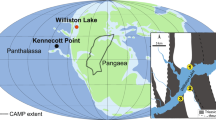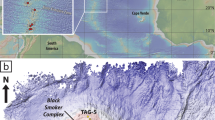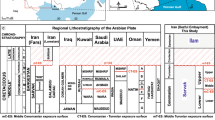Abstract
Carbonate–fluorapatite, the major component of marine phosphorite, forms within organic-rich diatomaceous sediments in present day conditions along the continental margin of Peru–Chile and South-West Africa (Namibia)1–4. Both of these areas are ‘West-Coast’ phosphogenic provinces5,6, characterized by an eastern boundary current, with strong coastal upwelling and associated high organic productivity. We report here the first radiometric evidence supporting Holocene apatite formation in an ‘East-Coast’ phosphogenic province, the East Australian continental margin, an area of only moderate seasonal upwelling7,8.
This is a preview of subscription content, access via your institution
Access options
Subscribe to this journal
Receive 51 print issues and online access
$199.00 per year
only $3.90 per issue
Buy this article
- Purchase on Springer Link
- Instant access to full article PDF
Prices may be subject to local taxes which are calculated during checkout
Similar content being viewed by others
References
Baturin, G. N., Merkulova, K. I. & Chalov, P. I. Mar. Geol. 13, M37–M41 (1972).
Veeh, H. H., Burnett, W. C. & Soutar, A. Science 181, 844–845 (1973).
Veeh, H. H., Calvert, S. E. & Price, N. B. Mar. Chem. 2, 189–202 (1974).
Burnett, W. C. & Veeh, H. H. Geochim. cosmochim. Acta 41, 755–764 (1977).
McKelvey, V. E. U.S. geol. Surv. Bull. 1252-D, 1–21 (1967).
McKelvey, V. E. & Wang, F. H. U.S. geol. Surv.Misc. Geol. Inv. Map. 1–632 (1969).
Rochford, D. J. Div. Fish. Oceanogr. Tech. Pap. No. 33 (CSIRO, 1972).
Rochford, D. J. Aust. J. mar. Freshwat. Res. 26, 233–243 (1975).
Jones, H. A., Davies, P. J. & Marshall, J. F. J. geol. Soc. Aust. 22, 71–78 (1975).
Marshall, J. F. BMR J. Aust. Geol. Geophys. 4, 281–288 (1979).
Boland, F. M. & Hamon, B. V. Deep Sea Res. 17, 777–794 (1970).
Godfrey, J. S., Cresswell, G. R., Golding, T. J., Pearce, A. F. & Boyd, R. J. phys. Oceanogr. 10, 430–440 (1980).
Von der Borch, C. C. J. geol. Soc. Aust. 16, 755–759 (1970).
Kress, A. G. & Veeh, H. H. Mar. Geol. 36, 143–157 (1980).
Bushinsky, G. I. Isr. Progr. Sci. Trans. Jerus. (1969).
Clarke, R. S. & Altschuler, A. S. Geochim. cosmochim. Acta 13, 127–142 (1958).
Kolodny, Y. & Kaplan, I. R. Geochim. cosmochim. Acta 34, 324 (1970).
Burnett, W. C., Veeh, H. H. & Soutar, A. SEPM Spec. publ. (in the press).
Pevear, D. R. Econ. Geol. 61, 251–256 (1966).
Author information
Authors and Affiliations
Rights and permissions
About this article
Cite this article
O'Brien, G., Veeh, H. Holocene phosphorite on the East Australian continental margin. Nature 288, 690–692 (1980). https://doi.org/10.1038/288690a0
Received:
Accepted:
Issue Date:
DOI: https://doi.org/10.1038/288690a0
This article is cited by
Comments
By submitting a comment you agree to abide by our Terms and Community Guidelines. If you find something abusive or that does not comply with our terms or guidelines please flag it as inappropriate.



